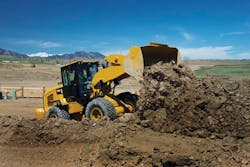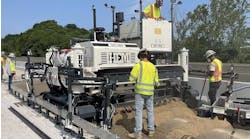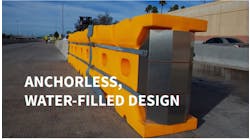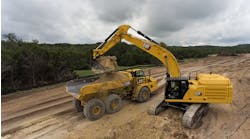The degree to which agencies and contractors invest in equipment often follows the tide of project-letting volume, which, in turn, follows the tide of available or expected funding.
In this regard, 2016—and, if the trend continues, 2017—has been steadily approaching high tide.
The ratification of the FAST Act has departments of transportation and contractors alike anticipating a swell in business—and planning accordingly. According to the Roads & Bridges Mid-Year Equipment survey, more than 85% of respondents expect this construction season to rate at least “good,” and of those, more than 35% expect it to rate as “very good” to “excellent.”
The cause for such optimism is an amalgamated result of the recent mild winter, which allowed work on many projects, large and small, to persist at a time when they would, under ordinary circumstances, have been suspended until spring; the imminent flush of federal funding that 85% of survey respondents expect to get their hands on by late summer or early fall; and the simple fact that more work is getting done this season than last season (so say 42%).
“What has been unique this year is the mild winter we had in the Northeast, which resulted in a continuation of construction jobs throughout the season,” Mike Anderson, vice president of Piscataway, N.J.-based Hoffman Equipment, which operates facilities all over New York and New Jersey, told Roads & Bridges. “With the election coming up, there seems to be some hesitation in the market, and though I predict there will be more hesitation as we get closer to the election, one thing that is helping the market are the large infrastructure projects going on.”
If business segments are not unlike the stock market in the sense that, to a certain degree, growth and loss are the speculative result of how companies “feel” about how things are going, then the construction equipment segment has begun to feel the pleasant sensation of healing from the last several bruising years. When asked “Have your feelings changed since the beginning of 2016,” nearly one-third of respondents indicated they feel better now than they did at the close of last year’s construction season.
The big-ticket stuff
“What is very hot right now for us is the heavy-highway stuff for roads and bridges,” Heath Watton, regional manager for Southeastern Equipment Co. Inc., which operates multiple locations throughout Ohio, Indiana, Michigan and Kentucky, told Roads & Bridges. “The large road and bridge customer is getting as much work as they can get done. We’re selling a lot of pavers, rollers, distributor trucks and chip spreaders. A lot of the money that has been subsidized from the government for the infrastructure has been a factor in the increase in sales in this market. Bridges are being replaced, so excavators with attachments are in demand. Indiana and Ohio are both strong markets for roads and bridges. There have been strong sales in the main heavy-highway products, such as pavers and remix units. A lot of the government entities have specified in their contracts that a remix paver or remix machine must be used because it helps keep the consistency with the temperature of the asphalt. So, when the asphalt is being put down, there is a consistency that helps to get the desired density.”
According to our survey, motor graders show a 6.5% uptick over 2015, a reflection of fleets upgrading outdated equipment and an increase in road-project letting.
Moreover, on-highway trucks (33%), excavators, both mini and full (28%), and wheel loaders (20%) are the high-demand items for firms going into summer. Next up on the list are skid steers (18%), though according to Watton that figure might be a bit conservative, in light of what he has been seeing.
“Skid steers have been trending strongly with contractors for the past two years,” Watton said. “It’s a popular piece of equipment for an owner/operator. They seem to be replacing the loader backhoe in the market. Excavators and skid steers have been strong in sales and rentals.”
This opinion also was reflected in survey results, which show skid steers up nearly 3% over 2015, while loader backhoes have dropped 1%, the differential accounting for a level itself equal to total demand for crushers/screeners and concrete pavers, respectively.
Jay Courtney, equipment division manager at McCann Industries, which operates multiple facilities in the Chicago metropolitan area and northwest Indiana, accedes to Watton’s view on heavy-duty equipment, as well as skid steers, as being a strong area this year.
“Skid steers, wheel loaders and compaction equipment have been the dominant machines for sales in the first quarter of 2016,” he told Roads & Bridges. “Mid-range dozers and heavy excavators are the bright spot, so far, for rental in 2016. The remainder of 2016 should be slightly up from last year in overall volume.”
The shady side
It’s not all sunny. As previously indicated by Hoffmann Equipment’s Mike Anderson, the impending election has caused some degree of trepidation, despite the assurance given by the FAST Act.
It is an opinion that does not lie alone.
“In an election year, equipment sales and rentals start tightening down,” Watton said. “Contractors will do without equipment because of the uncertainty of what lies ahead. If there is a lot of business, the owner will update his equipment, but still rent. If the market slows down, then you don’t need as many pieces. Consequently, there has been a decrease overall in equipment rental.” This view falls in agreement with survey results, which indicate more than 68% of respondents are not looking to rent more—this is in light of the percentage of respondents who are experiencing an increase in overall maintenance costs (58%).
“There has been a decrease in heavy dirt equipment, as well,” Watton went on. “Articulated trucks, large excavators, heavy crawlers and dozer sales are down because in eastern Ohio to western Pennsylvania and western Virginia, the oil and gas industry that was once booming and driving that market has now subsided. There are fewer drill sites being built.”
Another area that is seeing a slight downturn is used equipment sales. As new equipment releases meet more stringent emissions standards, the fleets they are replacing, which are comprised largely of Tier 3 and interim Tier 4 models, have begun flooding the used market. Unfortunately, they are entering some murky waters—or more to the point, a large oasis of unclear fuel options.
“Some specific construction equipment industry metrics are showing signs of a weakening used equipment market,” said Courtney, “partially because of Tier 4 emissions designs. Some of the late-model heavy equipment that traditionally has been sold to other countries is not being accepted now, because those areas cannot use Tier 4 machines. They don’t have the clean fuel to burn in them. This is beginning to show some negative effects for values of used equipment.”
In all, this throws some shade on an otherwise bright portrait of an industry growing once again comfortable flexing its depth and reach. Temperance is not uncommon in major industry; rather, it is a call sign of care—and so with care, the equipment segment crawls upward.



